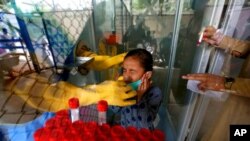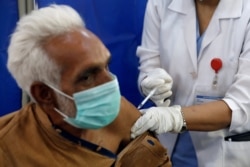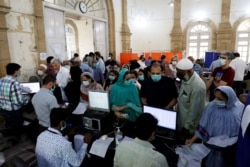Pakistan is struggling to contain a third wave of coronavirus infections, reporting close to 4,500 new cases in the last 24 hours, the highest number of daily infections in nine months.
Officials said Saturday that the rate of people testing positive for COVID-19 had alarmingly risen to more than 10% from a low of about 3% a couple weeks ago, suggesting the actual number of infections is likely much higher than the reported cases.
The overall number of infections and deaths from COVID-19, however, remains under control in Pakistan, a country of about 220 million people.
Since the pandemic hit the South Asian nation a year ago, officials have documented around 650,000 infections and about 14,200 deaths, including 67 fatalities recorded Friday.
British variant
Asad Umar, the minister who heads the National Command and Operation Center (NCOC) overseeing the government’s COVID-19 response, insisted Saturday that a British variant of the virus, detected in Pakistan early last month, was likely behind the flare-up in infections.
“This relatively more contagious and deadlier variant seems to be a major cause for the sudden and sharp increase in the spread of the disease," Umar told reporters after chairing an emergency meeting of the NCOC in Islamabad.
He added that public “disregard” for safety guidelines outlined by the government was contributing to the spread.
The minister said his office had already started receiving messages that hospitals across Pakistan were nearing capacity and that finding enough beds for coronavirus patients was becoming a challenge.
Call for public support
Umar urged people to strictly follow health and safety guidelines to help the government contain the infection, saying that bringing this “very dangerous situation” under control was impossible without public support.
The third coronavirus wave is largely being driven by a high number of cases reported in Punjab, the country’s most populous province, and the northwestern Khyber-Pakhtunkhwa province.
The Pakistani government earlier this week ordered educational institutions in high-risk districts across the two provinces and the national capital, Islamabad, to remain closed until April 11, tightening restrictions on public gatherings in those areas.
Meanwhile, Pakistan is struggling to keep the national COVID-19 vaccination campaign going because of supply challenges and vaccine hesitance.
Last month, the government began inoculating frontline health care workers and citizens age 60 and over after receiving a donation of 1 million doses of China’s Sinopharm vaccine. Beijing announced a donation of another 500,000 doses and Islamabad is awaiting the delivery.
Umar said this week that the national campaign had already vaccinated more than 700,000 people across Pakistan, raising concerns the government will soon run out of the drug.
Officials said Pakistan was supposed to receive several million doses of coronavirus vaccine from the World Health Organization's COVAX program in the first week of March.
But the vaccine did not come because of supply issues, and the delay has forced Islamabad to explore other options to fill the gap and try to ramp up the national vaccination drive.
COVAX aims to vaccinate people in low- and middle-income countries against COVID-19.
Purchases from China
Federal Health Minister Faisal Sultan said this week that his government had purchased just over a million doses of the Chinese vaccine and that the consignment would arrive in the country later this month. He added Pakistan was also planning to buy additional Chinese vaccine to ensure its citizens are inoculated against COVID-19.
WHO’s chief, Tedros Adhanom Ghebreyesus, urged the global community on Friday to donate COVID-19 vaccines to lower-income countries, citing the urgent need for 10 million doses for the COVAX vaccine distribution program.
“COVAX is ready to deliver but we can’t deliver vaccines we don’t have,” Tedros told a virtual news conference in Geneva.
“Bilateral deals, export bans and vaccine nationalism have caused distortions in the market with gross inequities in supply and demand,” Tedros said. “Ten million doses are not much and it’s not nearly enough.”











